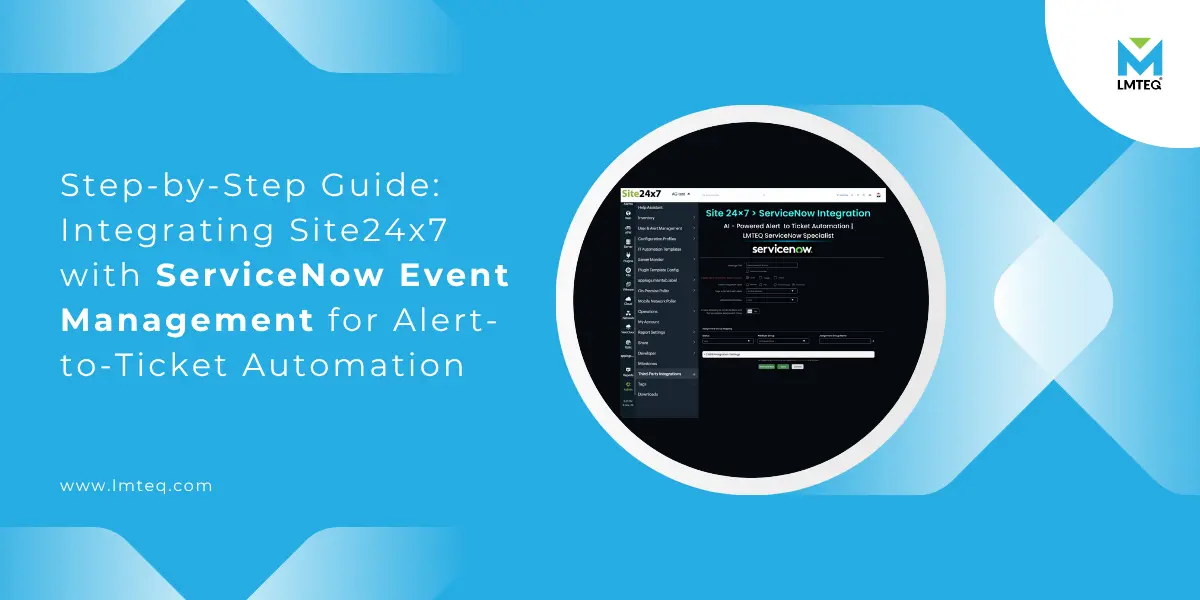Table of Contents
- Understanding the Concept – From Alert to Action
- A Gentle Introduction to AI Agents
- Why Integrate Site24x7 with ServiceNow?
- Prerequisites
- How the Integration Works
- Step-by-Step: Setting Up Site24x7 and ServiceNow Event Management Integration
- Common Use Cases for IT and Network Teams
- Troubleshooting Tips
- Key Metrics to Track Post-Integration
- Frequently Asked Questions (FAQs)
- Conclusion
In most IT and network operation centers, alerts arrive faster than teams can act on them. According to a recent Gartner study, over 60% of IT operations teams still spend more than 30% of their time manually triaging alerts from multiple monitoring tools — often missing critical incidents in the noise.
That’s where ServiceNow Event Management integration comes in.
By connecting Site24x7, a leading monitoring tool, with ServiceNow ITOM, you can automatically convert alerts into actionable incidents, ensuring no downtime goes unnoticed and no technician wastes time on redundant monitoring screens.
This guide walks you through step-by-step how to configure Site24x7 ServiceNow integration for alert-to-ticket automation.
Whether you’re a ServiceNow admin, a network engineer, or a Site24x7 user, this tutorial simplifies the entire setup for you.
Understanding the Concept – From Alert to Action
Let’s begin with what’s happening under the hood.
Site24x7 constantly monitors your servers, network devices, websites, and cloud resources. When something goes wrong, say a server is down or a disk reaches 95% usage, it sends an alert.
ServiceNow Event Management receives that alert, maps it to a configuration item (CI) in the CMDB, and automatically creates a ticket (incident) for your IT or network operations team to investigate.
This setup enables real-time alert management with ServiceNow, a crucial capability for proactive IT operations.
A Gentle Introduction to AI Agents
Before diving into configuration, it’s good to understand that ServiceNow ITOM is increasingly powered by AI-driven event correlation and noise reduction.
Think of these AI agents as smart assistants that automatically group related alerts, suppress duplicates, and predict impact areas.
When integrated with Site24x7, these agents can :-
- Recognize repetitive alerts and group them under one incident.
- Recommend next actions or auto-remediation workflows.
- Prioritize critical events based on historical patterns.
So while this integration focuses on automation setup, it also lays the groundwork for future AI-powered incident automation in ServiceNow.
Why Integrate Site24x7 with ServiceNow?
Here’s what your IT and network teams gain from ServiceNow alert-to-ticket automation :-
- End-to-end visibility – Get a unified view of alerts, tickets, and service health.
- Faster MTTR – Incidents are created automatically within seconds of detection.
- Reduced manual work – No more copy-paste from monitoring dashboards.
- Data-driven insights – Use event correlation to identify root causes faster.
- Seamless scalability – Works across hybrid cloud and on-prem environments.
This makes ServiceNow for IT operations not just a management tool, but a proactive problem-prevention platform.
Prerequisites
Before you start the ServiceNow Event Management integration, ensure you have the following ready :-
| Requirement | Description |
|---|---|
| ServiceNow Instance | With the Event Management plugin activated |
| Site24x7 Account | Admin-level access with API privileges |
| REST API Access | ServiceNow endpoint accessible via HTTPS |
| MID Server (Optional) | For on-premise or secure data flow |
| CMDB Configuration | CIs mapped to monitored devices |
| Credentials | Client ID, Client Secret, Auth Token from Site24x7 |
How the Integration Works
Here’s the basic data flow of ServiceNow ITOM integration with Site24x7 :-
- Site24x7 detects an issue → e.g., a database server goes down.
- Alert triggered → Site24x7 sends a webhook/REST call to ServiceNow.
- Event received in ServiceNow → Event rules process incoming JSON payload.
- Event-to-Incident Rule fires → Converts the alert into an incident.
- Incident assigned → Routed automatically to IT or network team.
This is what powers automated incident creation in ServiceNow — eliminating the need for human intervention in the alert triage process.
Step-by-Step: Setting Up Site24x7 and ServiceNow Event Management Integration
Step #1 – Generate Site24x7 Auth Token
- Log in to Site24x7
- Navigate to Admin → Developer → API → Generate Auth Token
- Copy down the following :-
- Client ID
- Client Secret
- Auth Token
Quick Tip :- Create a dedicated “ServiceNow Integration” user in Site24x7 to maintain clear audit trails and limited permissions.
Step #2 – Get Your ServiceNow REST API Endpoint
In your ServiceNow instance, note the endpoint used for event ingestion :-
https://.service-now.com/api/global/em/jsonv2
This is the URL Site24x7 will send alerts to.
Step 3: Create a New Outbound Integration in Site24x7
- Go to Admin → Third-Party Integrations → Add Integration
- Select Custom Integration → REST API / Webhook
- Enter :-
- Name: ServiceNow Event Integration
- URL: The endpoint from Step 2
- Method: POST
- Headers:
- Authorization: Bearer ServiceNow Auth Token
- Content-Type: application/json
Pro Tip :- Test your API token with a simple POST request using Postman before configuring it in Site24x7.
Step 4: Define the Alert Payload
You’ll now map Site24x7 fields to ServiceNow’s event parameters.
Sample JSON Payload :-
{
“records”: [{
“source”: “Site24x7”,
“node”: “$HOST_NAME”,
“resource”: “$MONITOR_NAME”,
“type”: “$MONITOR_TYPE”,
“severity”: “$STATUS”,
“description”: “$MONITOR_REASON”,
“time_of_event”: “$TIME_OF_ALERT”
}]
}
Quick Note :-
- Map $STATUS to ServiceNow severity :-
- DOWN → Critical
- TROUBLE → Warning
- UP → Clear
This mapping ensures consistent alert handling in your ServiceNow monitoring integration.
Step 5: Create Event Rules in ServiceNow
- Navigate to Event Management → Rules → Event Rules
- Click New
- Set the following conditions :-
- Source = Site24x7
- Node = Node name from payload
- Severity → Impact mapping
- Description → Short Description
- Under Actions, choose :-
- Correlate by Node and Resource
- Set Event Field → Assignment Group → Network Operations
These ServiceNow event rules determine how alerts are processed and categorized.
Step 6: Enable Event-to-Incident Conversion
- Go to Event Management → Rules → Event to Incident Rules
- Click New Rule
- Condition :- Source = Site24x7 and Severity = Critical
- Action: Create Incident and Assign to IT Operations group.
- Save and activate the rule.
Now, when Site24x7 sends a critical alert, ServiceNow automatically creates an incident – your ServiceNow alert to ticket automation is live!
Step 7: Test the Integration
Try simulating a failure :-
- In Site24x7, disable a monitored server or device.
- Wait for the alert.
- Within seconds, check ServiceNow :-
- The event appears in Event Management Dashboard.
- An incident is automatically created and linked to the CI.
If configured correctly, the incident will carry details like source, resource name, severity, and timestamp.
Step 8: Add Enrichment and Auto-Remediation
To make your ServiceNow IT operations workflow smarter :-
- Add fields like Device Owner, Business Service, and Impact Level via CMDB.
- Integrate ServiceNow Orchestration to trigger scripts — e.g., restart service or clear cache automatically.
- Leverage AI Ops within ServiceNow to suppress duplicate alerts and recommend probable causes.
Common Use Cases for IT and Network Teams
| Use Case | Site24x7 Alert Type | ServiceNow Action | Benefit |
|---|---|---|---|
| Server Down | Host Unreachable | Critical Incident | Faster recovery |
| Disk Space Full | Disk Utilization > 90% | Warning Event | Preventive maintenance |
| Network Latency | High RTT | Moderate Incident | Early network visibility |
| Application Crash | Process Not Running | Critical Ticket | Reduced downtime |
| Website Unavailable | HTTP 5xx | P1 Incident | SLA adherence |
These examples show how ServiceNow for network monitoring helps unify diverse alerts under one automated workflow.
Troubleshooting Tips
If incidents aren’t being created :-
- Check if ServiceNow credentials are valid.
- Verify that Event Rules and Event-to-Incident rules are active.
- Ensure payload formatting is correct (use JSON validators).
- Confirm network access between Site24x7 and ServiceNow.
Pro Tip :- Use the Test Integration option in Site24x7 to simulate events and see live logs in ServiceNow.
Key Metrics to Track Post-Integration
After deployment, monitor these success indicators :-
- Alert-to-ticket latency: Should be under 10 seconds.
- Duplicate incident rate: Less than 5%.
- Incident resolution time: Typically improves by 30–40%.
- Event correlation accuracy: Over 90% with AI rules enabled.
These metrics prove the business impact of your monitoring tools integration with ServiceNow.
Also Reads :-
Frequently Asked Questions (FAQs)
1. Is the Site24x7–ServiceNow integration available for all plans?
Yes. Site24x7’s REST API is available in Professional and Enterprise plans. You just need Event Management enabled in ServiceNow.
2. Can I customize event fields in ServiceNow?
Absolutely. You can extend or map custom fields like service name or region in your event rules for better incident clarity.
3. What’s the difference between alerts and events?
An alert is a signal from Site24x7; an event is how ServiceNow interprets it. Events can trigger incidents, tasks, or even remediation workflows.
Conclusion
Integrating Site24x7 with ServiceNow Event Management brings intelligence and speed to your IT and network operations. It ensures that every alert becomes an actionable, trackable, and resolvable task — without human delay.
The result? Reduced MTTR, improved uptime, and complete operational visibility from alert to resolution.
LMTEQ is a Preferred Specialist ServiceNow Consulting and Implementation Partner, specializing in ITOM integrations and AI-driven automation.
We help enterprises connect tools like Site24x7, SolarWinds, and Dynatrace with ServiceNow Event Management to achieve unified monitoring and rapid response.
If your IT or network team is ready to automate alert handling and reduce downtime, reach out to LMTEQ today to transform your operations with smarter workflows.

